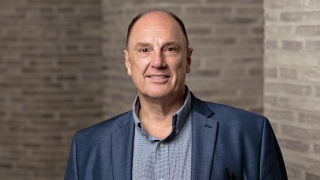
ABOVE Photo by Rob Strong.
Director's Foreword: Changing at the Speed of the Times
The year between July 2019 and June 2020 will long stand out for many reasons, not the least of which was the way it revealed the precarity of so much in our lives. The inequality of justice in the United States, the vulnerability of the food chain, universal access to medical care, the vulnerability of our environment, and the need for unfettered access to solid and defensible science have all taken center stage with an urgency unimaginable "before." All these issues have long simmered, bubbling over with increasing regularity. But with the marked uptick in racialized violence coincident with the onset of the immense pandemic of COVID-19, the country (and the world) both imploded and exploded.
For the Hood Museum of Art, the year began on an incredible high note. Within the first six months of opening our new building (January 2019 to July 2019), more people had visited than typically visit in a year, and we maintained that level of visitorship into the new fiscal year. Our new study center was functioning at peak capacity and our exhibitions were earning high marks in the press and on campus. In January of 2020, we opened seven new shows with curatorial teams representing students, graduate fellows, professors, guest curators, and our own curators. It was unprecedented to open that many new shows simultaneously and was meant to signal that the Hood Museum was back in the business of making important exhibitions. The galleries were packed with new art and ideas. At every turn, visitors were challenged and delighted in equal parts, spending time that was inspiring, informative, and eye-opening. The spring lineup, promising the same level of intensity and discovery, was set to open on March 14—and we closed on March 13.
All around us the country imploded, with atrocities playing out like a slow-motion lowlights reel on our televisions. Breonna Taylor was killed on the day the Hood Museum closed—the news of her homicide reaching us as we set in the first stocks of supplies to ride out the pandemic. George Floyd's killing followed. In the meantime, with the economy plummeting, layoffs and furloughs defined life for a vast number of people. Immediately, the inequities in access to food and medicine led to shortages, hoarding, and lines of people waiting for fundamentals.
The explosions that followed revealed a populace determined to change the status quo, to fight injustice, and to create new alliances in this fight. Protest has swept the country—unrelenting protest. The Black Lives Matter movement shifted from occasional flare-ups to the leading social movement in the country. Both sides of the political spectrum have taken to the streets. There has been violence. There have been moments of collective beauty. Tears of sadness and of joy.
Through all this the Hood began transforming. While it remains too early for clarity, the museum—long committed to exploring social issues and to foregrounding these in its programming—moved in March to rethink what a museum does, how it acts, and what it stands for. The essential question for us as the fiscal year drew to a close in June: How do we contribute concretely to making the world a better, more just and equitable place? Stay tuned.
John R. Stomberg
The Virginia Rice Kelsey 1961s Director